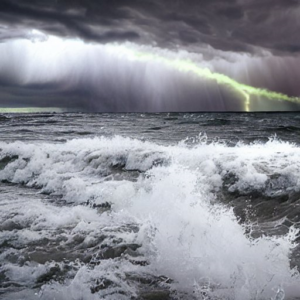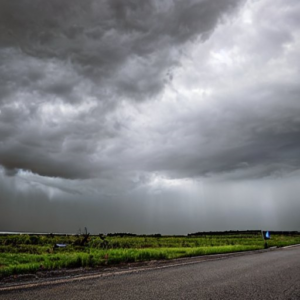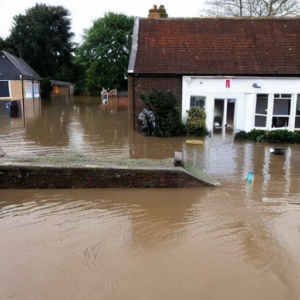This blog has been written by The Flood Hub People.
On the 29th of August 2024, the Met Office, in collaboration with Met Éireann (the meteorological service in Ireland) and the KNMI (the Dutch national weather service), released the storm names for the 2024/25 season! Before we look at this year’s list of names, let’s take a closer look at the practice of naming storms as well as some of the more notable storms and their impacts from recent years.
The tradition of naming storms began in 1953 in the United States when the National Hurricane Centre (now the World Meteorological Organisation) began assigning female names to storms and hurricanes, with male names introduced from 1978 onwards. However, it wasn’t until 2014 that the Met Office in the UK decided to start giving storms male and female names in a similar tradition.
The Met Office, Met Éireann, and the KNMI select each year’s list of names from suggestions submitted by the public. The names are selected based on popularity and how well they represent the different cultures, nations and diversity across Britain and Ireland. Storm names are assigned in alphabetical order, however, to remain in line with the US National Hurricane naming conventions, storms are never assigned names beginning with the letters Q, U, X, Y and Z.

Only storms that are suspected to cause considerable damage or trigger an amber or red warning (medium or high impacts) are given a name. This is because naming storms helps to make them more personable and relatable to the general public, which helps to raise awareness of the severe weather that a storm can bring, how dangerous they can be and the damaging effects they can have.
Storms can bring a range of disruptive and sometimes life-threatening weather events, including heavy rain and flooding, strong winds, storm surges and freezing rain. Therefore, it is important to be prepared and stay as safe and resilient as possible against the potential impacts.
Storms can bring some of the most severe and extreme weather events during the winter months, including lower temperatures, gale-force winds, and heavy precipitation, which can result in flooding. Storms occur at mid-latitudes where cold polar air meets warmer tropical air, and the point at which the two temperature differentials meet is known as the jet stream. Rising air from the Atlantic is replaced by the strong winds of the jet stream much quicker than the air at lower levels, and this reduction in pressure produces the strong winds of winter storms. Storms tend to form in the winter months when the temperature between the air masses is at its greatest.

Before we take a look at the chosen names for the 2024/25 storm season, let’s take a quick look at some of the more notable storms which have impacted the north of England quite significantly over recent years…
On the 5th and 6th December 2015, Storm Desmond brought strong winds of up to 81 mph and heavy rainfall, with 341.4mm of rain falling across Cumbria over 24hours on the 5th December. Many people across Cumbria and Lancashire were severely affected, with 5,200 homes flooded and 61,000 homes in Lancaster left without power when an electrical substation was flooded. Major roads were flooded across the north of England and Scotland, together with disruption to rail services, including a landslide which closed part of the West Coast mainline between Preston and Carlisle. Many homes and businesses were destroyed across the north of England and twelve months on, 1 in 5 homeowners were yet to return home.
Storm Eva brought prolonged and intense rainfall to already saturated catchments across Northwest England, due to earlier months of rainfall. River levels reached record highs, with the Irwell catchment recording 128mm of rainfall in 36 hours across Christmas Day and Boxing Day. This resulted in 2,250 homes and 500 businesses across eight local authority areas being flooded, with tens of thousands of people experiencing disruption from power cuts and road closures. In Lancashire, the river Calder burst its banks flooding communities in Whalley and Billington, resulting in many families needing to evacuate their homes.

Image: From video by J Whipps / Whalley flood recovery, Lancashire
Storm Ciara swept across the UK bringing high winds and heavy rainfall with a maximum wind speed of 97mph recorded at the Isle of Wight. Large amounts of rainfall affected much of Northwest England and North Wales, with Honister Pass gauge station in Cumbria recording 177mm of rain in the 24hr period leading up to 4pm on Sunday 9th February. A total of around 539,000 properties experienced power cuts across the UK and the Environment Agency issued 251 Flood Warnings, with many homes flooded and evacuated across the Northwest.
Less than a week after Storm Ciara, Storm Dennis brought additional widespread rain with between 150mm and 250mm falling across northern England, further exacerbating impacts on communities with a second wave of flooding. Properties were flooded in Tenbury Wells, Worcestershire as well as in Lowdham, Nottinghamshire and Pontypridd in Wales. Rail disruptions were also widespread.
Storm Christoph brought the wettest 3-day period of rainfall on record for Northwest England and North Wales, with over 100mm of rain falling across upland areas. Parts of Cheshire, Greater Manchester and Lancashire received a whole months’ worth of rain. Homes were flooded in Cheshire, with most of Northwich town centre under water, and further homes were evacuated in Chester, Warrington, Didsbury and Northenden in Manchester. As Storm Christoph moved eastwards, the northeast region experienced snowfall and blizzards, with emergency response and evacuation efforts hindered by the Coronavirus pandemic.

The 2023/24 storm season has been an active one and set a new record with 12 named storms. The naming of storms in the UK started with the 2015/16 storm season and whilst we only have storm names data for the previous eight years, we’ve averaged around 7 storms per storm season. Until this year, the very first storm season (2015/16) held the record for the greatest number of storms per season at 11. You can see a breakdown of previous years’ number of storms in the table below…
| Year | No. of Storms | Name of last storm |
| 2015/16 | 11 | Katie |
| 2016/17 | 5 | Ewan |
| 2017/18 | 8 | Hector |
| 2018/19 | 8 | Hannah |
| 2019/20 | 6 | Francis |
| 2020/21 | 5 | Evert |
| 2021/22 | 6 | Franklin |
| 2022/23 | 2 | Betty |
| 2023/24 | 12 | Lilian |
Storm Babet brought strong winds and heavy and persistent rainfall to North East England and parts of eastern Scotland which saw the Met Office issuing two red warnings for rain, and multiple flood warning issued by both the Environment Agency (EA) and the Scottish Environmental Protection Agency (SEPA). At least seven people were reported to have died and over 1000 homes in England were affected by flooding across the East Midlands, Yorkshire and the Humber region. Over 500 properties were evacuated in Retford, Nottinghamshire, and around 400 homes were flooded in Chesterfield, Derbyshire, with a major incident declared in Suffolk. Rail services on the east coast were also disrupted due to flooded rail tracks.
Storm Ciaran was a particularly severe storm and while Northern France and the Channel Islands saw the worst effects, the south of the UK saw major disruption to rail services and cancelled flights. The Isle of Wight and Hampshire declared major incidents, while the port of Dover closed temporarily as large waves battered the coast resulting in cancelled ferry services and cars being swept into the sea. Around 150,000 homes were left without power and schools were forced to close as many rivers burst their banks causing flooding, and a power outage at three water treatment plants left thousands of resident and businesses without water.
Storm Gerrit brought high winds and heavy rain with Wales, north-west England and Scotland affected the worst. Severe travel disruption to roads and rail networks impacted travellers with landslips, flooding and fallen trees. Thousands of properties were left without power in Scotland and a major incident was declared in Staley bridge, Manchester after a mini tornado damaged over 100 homes. In addition, temporary flood barriers were deployed along stretches of the River Severn in Worcester in anticipation of flooding.
Following an already wet December 2023, Storm Henk brought damaging winds and heavy rain which contributed to significant flooding. Almost 300 Flood Warnings were issued in England and hundreds of properties in the West Midlands were flooded from the River Severn. The River Ouse breached its banks flooding properties in York and further properties also flooded in Wales. High winds led to road closures, hindered aircraft landings at major airports and resulted in the loss of power to around 38,000 homes due to fallen trees bringing down power lines. High winds and fallen trees were also responsible for large scale disruptions to the rail network and sadly, the loss of life for two people.
The MET Office has just released this years’ Storm names, how far down the list do you think we will get this year? Take a look at the list below to see if your name is on the list!
| Storm Name | Date named | Date of impact on UK and/or Ireland and/or Netherlands |
| Ashley | 18th October 2024 | 20th – 21st October 2024 |
| Bert | 21st November 2024 | 22nd – 25th November 2024 |
| Conall | 26th November 2024 | 27th November 2024 |
| Darrah | 5th December 2024 | 6th – 7th December 2024 |
| Eowyn | 21st January 2025 | 24th January 2025 |
| Floris | 1st August 2025 | 4th – 5th August 2025 |
| Gerben | ||
| Hugo | ||
| Izzy | ||
| James | ||
| Kayleigh | ||
| Lewis | ||
| Mavis | ||
| Naoise | ||
| Otje | ||
| Poppy | ||
| Rafi | ||
| Sayuri | ||
| Tilly | ||
| Vivienne | ||
| Wren |
You can submit storm name suggestions for the 2025/26 season by making a submission through the MET Office online form here: https://www.metoffice.gov.uk/forms/name-our-storms-call-for-names, or via email at: [email protected].
Source: MET Office, BBC